3sr+buyer
Active Member
The plug blade contacts shown in the above photos of the apparent Hubbell RR450FW do not look like they are brass. If they are steel, that could mean higher resistance and heat generation.
You can install our site as a web app on your iOS device by utilizing the Add to Home Screen feature in Safari. Please see this thread for more details on this.
Note: This feature may not be available in some browsers.
True. i2r losses increase dramatically with current. But they are probably much less than the few hundred watts of idle current required during charging, regardless of charging rate. Someone tested this on the older chargers and TLDR, highest efficiency was largest current and even numbers. (32 / 24A / etc). That might have been with the older on board chargers, though.I disagree with using the highest current setting while charging because of stressing these plug in connections which we have proof of being problematic. As far as charging efficiency, even # wire gets hot when charging at 40A. Heat is wasted energy. So while 5A is probably not the most efficient charge rate, I'd contend that neither is 40A. I'd recommend charging at somewhere from 10 to 30A. Unless that won't get you enough charge to be ready for your next drive.
That's right - if you've got anywhere near 350 watts (the vehicle's overhead) of loss between your meter and the EVSE when charging at the maximum current, either something isn't up to code or is faulty.True. i2r losses increase dramatically with current. But they are probably much less than the few hundred watts of idle current required during charging, regardless of charging rate.
9450A, IF you have copper wiring.
I saw that, but I didn't want to assume that was copper and accidentally cause someone to burn their house down.From the first photo @GetYourWheels posted, it looks like copper wiring to me.
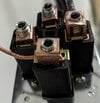
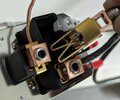
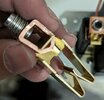
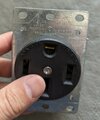
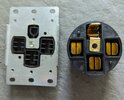
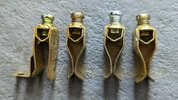
Thanks for posting, but from your pictures, both the box terminals as well as the contacts are completely different design.I recently took apart a Bryan 14-50 and a cheap DR50-4S that I used for going on 5 years. The difference was not all that amazing like everyone makes it seem. I think the only failure point here is just making sure you got the wire under the terminal screw and torque it correctly on the cheap one. The Bryant has a clamping terminal so you can't really mess it up.
Bryant:
View attachment 1052941View attachment 1052942View attachment 1052943
DR50-4S:
View attachment 1052946View attachment 1052947View attachment 1052948
Yeah, the Bryant has a far better clamping mechanism, not to mention a big hunk of copper that directly contacts the wire. More expensive to manufacture, though!Thanks for posting, but from your pictures, both the box terminals as well as the contacts are completely different design.
The terminal design of the Bryant has the screw push on the flat section that is directly part of the contacts, and has the triangle shape to clamp it. This is a much more secure connection (screw terminals seem to be one of the most common failure points of the residential outlets), and it also ensures the best contact area (unlike depending on the screw itself to push down).
The way the contacts are bent also is completely different. It explains why the Bryant's contacts feels so much tighter than any other outlet I've used.
However, lower amperage charging will consume more energy, since the car will be turned on for a longer period of time due to the longer time spent charging (the car being turned on takes 400-500W versus probably around 25W when turned off).Quick update and 2 cents from my end: I replaced my Leviton ($10) outlet that was running hot lately with the Bryant ($50). I know Bryant is definitely better than the Leviton but I plan on charging with a 16A setting anyways. Sufficient rate for my daily use when I charge overnight.
See question 1 on post 890.I have a Hubbell receptacle (bought from a contractor store not online, so its legit)...
How have you verified this?However, lower amperage charging will consume more energy, since the car will be turned on for a longer period of time due to the longer time spent charging (the car being turned on takes 400-500W versus probably around 25W when turned off).
Scan My Tesla reports >0.4kW consumption while the car is on. This also matches the drain people complain about when sentry mode is on.How have you verified this?
Sorry, I thought it was Hubbell, but its actually Bryant 9450FR, which I guess is owned by Hubbell.See question 1 on post 890.

In February 2023, I asked Hubbell, "Can you please indicate any differences between the Hubbell 9450A and the Bryant 9450FR? They appear identical other than the 9450A has the brand name molded into the receptacle while the 9450FR has it stamped/engraved on the mounting strap. I need to verify that the cosmetic difference is the only difference between these two devices and that they are otherwise identical in quality, materials, specifications, ratings, approvals, etc. Are they made in the same location using the same tooling? Thank you in advance for any information you can provide."Sorry, I thought it was Hubbell, but its actually Bryant 9450FR, which I guess is owned by Hubbell.


